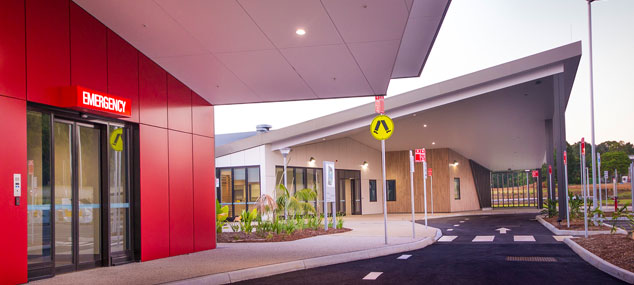
Public hospitals across Northern NSW Local Health District (NNSWLHD) continued to deliver high quality, timely care to the community amid high levels of activity in the most recent quarterly reporting period.
The latest Bureau of Health Information (BHI) Healthcare Quarterly report (January to March 2023) shows there were 54,913 attendances to NNSWLHD emergency departments.
Acting Chief Executive for Northern NSW Local Health District, Lynne Weir, said staff were providing excellent care to the community in the wake of local challenges.
“After a difficult year following the devastating floods in Northern NSW, our staff and our health system are continuing to put patients at the forefront of all we do,” Ms Weir said.
More than 7 in 10 patients (74.6 per cent) started treatment on time, which is better than the NSW state average (67.4 per cent), and the third consecutive quarter of improvement for the District.
More than 8 in 10 patients (81.1 per cent) were transferred from ambulance to ED staff within the 30-minute benchmark, which is better than the state average (77.7 per cent).
The majority of patients (72.5 per cent) left the ED within 4 hours, also better than the NSW average (58.2 per cent).
“Our new Patient Flow Unit continues to improve the transfer of patients throughout our hospitals, placing patients in the right place for the right care, at the right time,” Ms Weir said.
A total of 3,530 planned surgeries were performed across the region, with nearly all urgent planned surgery (94.9 per cent) performed on time.
“We are continuing to collaborate with private hospitals in the region to provide additional surgical care to our residents,” Ms Weir said.
“Our teams have worked incredibly hard to increase our surgery capacity, resulting in no Category 1 (Urgent) procedures being overdue at the end of the March 2023 quarter.”
“We have also seen significant reductions in the number of overdue Category 2 and 3 cases in 2023.”
Any patients who feel their condition has deteriorated while waiting for their procedure are encouraged to contact their treating doctor for a clinical review.
The 2022-23 budget for Northern NSW Local Health District is more than $985 million, an increase of more than $40 million, or 4.3 per cent more, on the previous year’s budget.
INDIVIDUAL HOSPITAL RESULTS
BALLINA DISTRICT HOSPITAL had 4,514 ED attendances during the quarter. The majority of patients (70.1 per cent) started their treatment on time. More than seven in 10 patients (74.5 per cent) left the ED within 4 hours. More than 8 in 10 patients (84.3 per cent) were transferred from ambulance to ED staff within the 30-minute benchmark.
BYRON CENTRAL HOSPITAL had 5,908 ED attendances and 8 in 10 patients (82.8 per cent) started their treatment on time, which is better than the average for hospitals of a similar size in NSW (78.4 per cent). Nearly all patients (95.5 per cent) were transferred from ambulance to ED staff within the 30-minute benchmark, also better than the average for hospitals of a similar size in NSW (93.9 per cent).
CASINO & DISTRICT MEMORIAL HOSPITAL had 3,463 ED attendances in the quarter. The vast majority of patients (84.5 per cent) left the ED within 4 hours of arriving, which is better than the average for hospitals of a similar size in NSW (79.3 per cent). More than 9 in 10 patients (92.9 per cent) were transferred from ambulance to ED staff within the 30-minute benchmark.
GRAFTON BASE HOSPITAL had 6,961 ED attendances during this quarter. The majority of patients (68 per cent) started treatment on time, and almost 7 in 10 patients (69.3 per cent) left the ED within 4 hours, which is better than the average for comparable hospitals in NSW (64 per cent). Almost 9 in 10 patients (89.7 per cent) were transferred from ambulance to ED staff within the 30-minute benchmark.
LISMORE BASE HOSPITAL had 9,848 ED attendances during the quarter. The majority of patients (61.2 per cent) started treatment on time. More than 7 in 10 patients (77.2 per cent) were transferred from ambulance to ED staff within the 30-minute benchmark, which is in line with the average for hospitals of a similar size in NSW (77 per cent).
MACLEAN DISTRICT HOSPITAL had 3,957 ED attendances during the quarter. More than 8 in 10 patients (83.8 per cent) started their treatment on time, which is better than the average for hospitals of a similar size in NSW (78.4 per cent). Almost 9 in 10 patients (89.7 per cent) left the ED within 4 hours, which is significantly better than the average for comparable hospitals in NSW (79.3 per cent). Nearly all patients (93.1 per cent) were transferred from ambulance to ED staff within the 30-minute benchmark.
MURWILLUMBAH DISTRICT HOSPITAL had 4,578 ED attendances during the quarter. The majority of patients (85.8 per cent) started their treatment on time, which is better than the average for hospitals of a similar size in NSW (71 per cent). More than 8 in 10 patients (84.6 per cent) left the ED within 4 hours. Almost all patients (96.3 per cent) were transferred from ambulance to ED staff within the 30-minute benchmark.
THE TWEED HOSPITAL had 13,694 ED attendances during the quarter. More than 7 in 10 patients (79 per cent) started their treatment on time, which is better than the average for hospitals of a similar size in NSW (64.6 per cent). Almost 7 in 10 patients (69 per cent) left the ED within 4 hours of arriving, which is also better than the average for comparable hospitals in NSW (53.9 per cent).